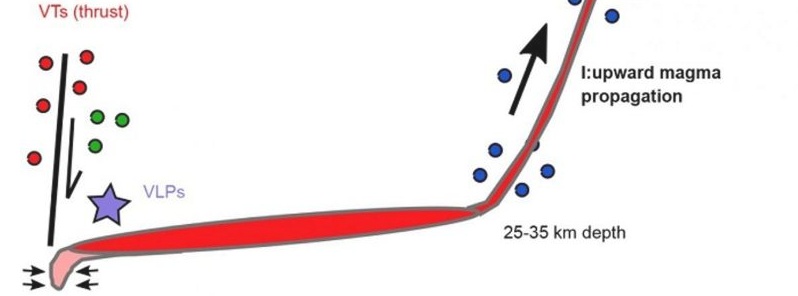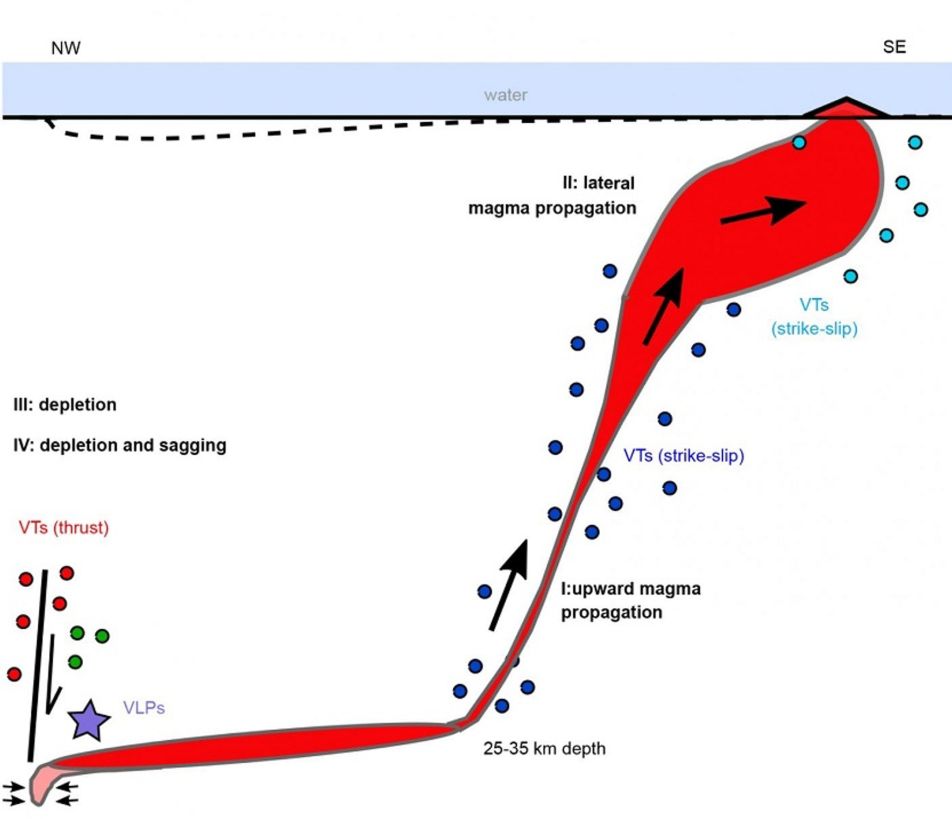Enormous underwater eruption that almost went unnoticed — formation of a huge new volcano near Mayotte

A new underwater volcano formed near the island of Mayotte in the Indian Ocean in 2018, which was confirmed in May 2019. Now, an international team of scientists is unraveling the dramatic events that led to its creation. It is the deepest and largest magma reservoir in the upper mantle to date, which is beginning to empty abruptly, the researchers said. However, since the seabed lies 3 km (2 miles) below the water surface, almost nobody noticed the enormous eruption.
Since May 2018, an unusual series of earthquakes started being registered off the coast of the island of Mayotte, the oldest volcanic island in the Comoros Basin grouping.
An entirely new form of earthquake signal has emerged since June 2018– it was so powerful that it could be recorded thousands of kilometers away. The signals lasted up to 30 minutes and were characterized by particularly harmonic, low frequencies, almost monochromatic. They are similar to a large bell or a double bass and are called Very Long Period (VLP) signals.
Despite the seismic activity's center being 35 km (22 miles) offshore the east coast of the island, a continuous lowering and eastward motion of the earth's surface started at the same period as the massive swarms of VLP signal begun, accumulating to roughly 20 cm (8 inches) to date.
Scientists led by Simone Cesca from Germany's GeoFrorschungsZentrum (GFZ) examined seismological and geodetic data from the region to further study the observations and their evolution. However, there was no seismic network on the seafloor, complicating the investigations.
"We tried to improve the unfavorable initial situation by developing special new analytical methods such as cluster and directional beam methods," Cesca stated.
The team determined different activity phases within the series of events from May 2018 up to the present. The initial swarm period specified a quick upward movement of magma from a deep mantle reservoir over 30 km (19 miles) below the surface.

Image credit: Cesca et al.
The magma then started to flow once an open channel had formed from the mantle to the seabed. An oceanographic campaign confirmed in 2019 the birth of the underwater volcano, whose location concurs with the reconstructed magma rise.
The apparent tectonic termor activity lessened again in this phase, while the lowering of the ground on the island started. Similarly, long-lasting mono-frequent VLP signals began.
"We interpret this as a sign of the collapse of the deep magma chamber off the coast of Mayotte," said co-author Eleonora Rivalta. "It is the deepest and largest magma reservoir in the upper mantle to date, which is beginning to empty abruptly."
"Since the seabed lies 3 km (2 miles) below the water surface, almost nobody noticed the enormous eruption," said Torsten Dahm, Head of the section Physics of Earthquakes and Volcanoes at the GFZ.
"However, there are still possible hazards for the island of Mayotte today, as the Earth's crust above the deep reservoir could continue to collapse, triggering stronger earthquakes."
Related articles:
December 04, 2019
Eruption of underwater volcano near Mayotte continues, may badly affect Lake Dziani on Petite Terre
November 21, 2019
Newly forming underwater volcano discovered near Mayotte, source of intense earthquake swarm
May 17, 2019
Mayotte seismo-volcanic crisis: Significant subsidence detected, observation campaign launched
March 13, 2019
Large number of dead fish, sulfur smell reported, Mayotte seismo-volcanic crisis intensifies
January 16, 2019
Seismic waves near Mayotte characteristic of volcanic phenomena
November 29, 2018
Abnormal earthquake swarm near Mayotte continues, constant shaking creating anxiety and stress
July 02, 2018
Earthquake swarm near Mayotte, oldest volcanic island in the Comoros basin
May 15, 2018
Reference:
"Drainage of a deep magma reservoir near Mayotte inferred from seismicity and deformation" – Cesca, S. et al – Nature Geoscience – DOI: 10.1038/s41561-019-0505-5
Abstract
The dynamics of magma deep in the Earth’s crust are difficult to capture by geophysical monitoring. Since May 2018, a seismically quiet area offshore of Mayotte in the western Indian Ocean has been affected by complex seismic activity, including long-duration, very-long-period signals detected globally. Global Navigation Satellite System stations on Mayotte have also recorded a large surface deflation offshore. Here we analyse regional and global seismic and deformation data to provide a one-year-long detailed picture of a deep, rare magmatic process. We identify about 7,000 volcano-tectonic earthquakes and 407 very-long-period seismic signals. Early earthquakes migrated upward in response to a magmatic dyke propagating from Moho depth to the surface, whereas later events marked the progressive failure of the roof of a magma reservoir, triggering its resonance. An analysis of the very-long-period seismicity and deformation suggests that at least 1.3 km3 of magma drained from a reservoir of 10 to 15 km diameter at 25 to 35 km depth. We demonstrate that such deep offshore magmatic activity can be captured without any on-site monitoring.
Feature image credit: Cesca et al.

Jamal shrair I agree with your analysis completely. It’s the cosmic rays in our atmosphere and earth’s interior. We’re looking at cycles in history repeating.
This area has been of interest to me as well in recent years. Imo, the South African Magnetic Anomaly is correlated with large quakes on the Cascadia fault zone. So the series of quakes at Mayotte made me wonder if the SAMA is getting close to a shift.
Mayotte and Volcano, Hawaii was not the first related antipodal seismological/vulcanological event noted in the last few years; just the most active and long lasting. Currently, the last few days with Puerto Rico and Indonesia active at the same time as NMSZ, I beg the question of ‘just how much relationship is there between these apparently disconnected events around the globe’?
I made a prediction last March that the NMSZ has a good probability for a large quake during this winter. My best guess according to the clues I use suggest that the new moon on the 24th of this month is the prime point. Although I also rate the 10th through the 12th during the full moon as a probable time for a large quake, perhaps at Puerto Rico. Imo, if there is going to be a main event quake at PR, then it could occur over this weekend.
stock here
been on this well over a year
https://www.nukepro.net/2019/05/hawaii-madagascar-connected-via-strange.html
original work by me. stock out.
————————————————————-
Something big happened on our Earth in May of 2018. I upgraded my technology with HelioViewer and watching 10 episodes of Heliophysics from Suspicious 0bservers. Go to the bottom for relevant information to the Madagascar (Mayotte Island) EQ and Vulcanism.
Large EQ started happening North of Madagascar, daily or multiple EQ daily, when in prior years, there were hundreds of days apart for any large EQ.
This coincided with the Hawaii 2018 Vulcanism, and looks very related.
I have stated in my research paper that was published two years ago, the following: The massive increase in the number of underwater volcanoes, that were detected in the last 26 years and also the formation of many new islands around the globe have exposed the pseudoscience of man-made climate change. It is the increase of extraterrestrial energy at the earth’s interior which is the fundamental cause for the climate change and temperature change of the oceans. Moreover, the increase of extraterrestrial energy at the earth’s interior is also the reason for the increase in earthquakes and volcanic eruptions. When the optimum energy level will be reached, the geomagnetic reversal will take place accompanied by massive geological upheaval. This has happened many times throughout earth’s history. https://www.gsjournal.net/Science-Journals/Research%20Papers-Climate%20Studies/Download/7186